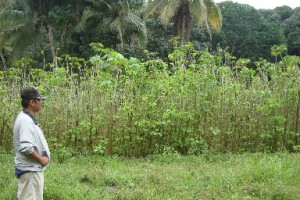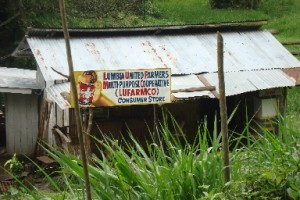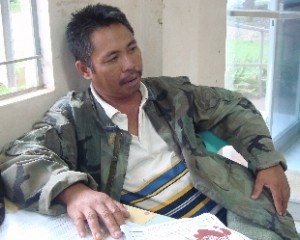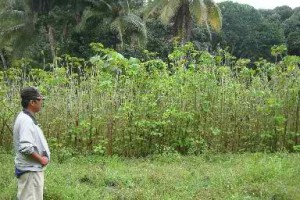By LIEZL P. BUGTAY and VENUS P. BETITA
AFRIM
 A promise of prosperity turned into a bitter cautionary tale for a community that had pinned its hopes on an alternative energy project in Cagayan de Oro. Rather than benefiting from a much-vaunted government project, the farmers whose lands were planted to jathropa became victims of what they now believe was a swindle.
A promise of prosperity turned into a bitter cautionary tale for a community that had pinned its hopes on an alternative energy project in Cagayan de Oro. Rather than benefiting from a much-vaunted government project, the farmers whose lands were planted to jathropa became victims of what they now believe was a swindle.
About four years ago, the Higaonon tribal community in Brgy. Lumbia agreed to take part in a jathropa production venture with an organization claiming to be in partnership with the Philippine National Oil Co.-Alternative Fuels Co. (PNOC-AFC).
Jathropa, also known locally as “tuba-tuba,” is a drought-resistant shrub that is considered the best source of fuel among plants. Its seeds, which are the size of walnuts, are pressed and extracted for oil. About 30 percent of a jathropa nut is made up of oil. According to the Department of Agriculture, 2.9 kilos of seeds can produce one liter of crude oil.
Aside from being a cheap source of alternative fuel for vehicles, jathropa can also be used for producing soap and fertilizer. Because the plant can withstand drought and produce harvests a year or two after planting, developing countries have begun encouraging farmers to turn their lands into jathropa plantations. Today, the crop is being promoted for priority cultivation in Mindanao.
Manang Bebeng Domo, a long-time barangay official of Barangay Lumbia and now also a member of the council of elders, remembers the events that started in June 2007 and jolted her highland community from their peaceful life.
Two other cooperative leaders—Manong Nick Ragasajo and Paulino Pastor—who were actively engaged in the “venture” also displayed remorse over their unpleasant experience.
According to Manang Bebeng and Manong Nick, it all started when Pacita Panis, chairperson of Tribal Communities Association of the Philippines (TRICAP), offered a partnership with the Lumbia United Farmers Multipurpose Cooperative (LUFARMCO) for a business venture on jathropa production under the PNOC-AFC.
The deal was simple: percentage sharing based on the current fuel price of biofuel. Two-thirds of the fuel income would go to PNOC and the remaining one-third to the farmers. From earnings of P45 per liter, P30 would go to the PNOC and P15 to the farmers.
At that time, the Philippine government was actively pursuing the development of alternative fuel to meet the challenge of rising oil prices in the world market and to ease its dependence on petroleum. Through the Biofuels Act of 2006, which promotes the use of alternative fuel like biofuels and biodiesel, the government identified certain crops as possible energy sources such as jathropa, cassava, corn, oil palm and coconut.
As a state-subsidiary corporation, the PNOC-AFC committed to propagate the government’s biofuel programs through its research initiatives with the University of the Philippines Los Baños and actual field-testing. Actual field test areas included places like Talakag and Camp Kibaritan in Bukidnon, Fort Magsaysay in Nueva Ecija, the Royal Green Energy Development Corp. in Palawan, and Barangays Lumbia and Pagatpat in Cagayan de Oro City. Brgy. Lumbia residents did not know that their barangay was one of the field test sites.
Without much ado, a memorandum of agreement was signed among PNOC-AFC, TRICAP and Lumbia Council of Elders (LUCEL). The council was formed to fast-track the approval since the project prioritized indigenous peoples. Panis represented both the PNOC-AFC and TRICAP while Manong Nick represented the council. The initial target for jathropa production was 500 hectares covering three highland barangays in Cagayan de Oro City. Sixty-five hectares of the land were in Brgy. Lumbia.
 At the start, farm laborers were hired to clear the identified area and plant jathropa. In return, they will be paid daily wages of P150. The landowners agreed to be part of the project even without charging rent because of the livelihood package promised to them. Since most of the areas were idle lands, the landowners welcomed the project, thinking this would develop their property. The package included the distribution of free vegetable seedlings that can be intercropped with jathropa. Such vegetables could be intercropped as long as these would not be higher than the height of the jathropa.
At the start, farm laborers were hired to clear the identified area and plant jathropa. In return, they will be paid daily wages of P150. The landowners agreed to be part of the project even without charging rent because of the livelihood package promised to them. Since most of the areas were idle lands, the landowners welcomed the project, thinking this would develop their property. The package included the distribution of free vegetable seedlings that can be intercropped with jathropa. Such vegetables could be intercropped as long as these would not be higher than the height of the jathropa.
Persons who would work as supervisors were hired from the barangays. For a monthly pay of P10,000, they were to be in charge of the laborers who would be clearing the area, planting jathropa, fertilizing the land and maintaining the crops. In Lumbia, two supervisors were hired. One of them was Manong Paulino.
To make the project acceptable to the people, TRICAP promised as part of the “social preparation” the implementation of infrastructure and other projects. Roads would be built and trainings conducted on jathropa production, livestock raising and other agricultural activities. The trainings would be conducted by resource persons from the Department of Agriculture (DA) and Department of Agrarian Reform (DAR). For the landowners, the fact that construction of farm roads is part of the livelihood package made them even happier.
And so the project commenced. About 65 hectares were cleared and planted with jathropa in Barangay Lumbia for the first phase which ran from June to September 2007. Wages were paid weekly at the barangay hall without any hitch. People welcomed the business venture and took extra steps to make it succeed. Manang Bebeng, for example, offered the use of her vehicle so seedlings could be distributed and farm workers transported to their workplace. She would also advance some cash for wages and meals of the workers when the budget for the project was delayed.
The residents of Barangay Lumbia never thought that something would go wrong. How could they have? As Manong Paulino said, officials from the national government riding in a helicopter even took videos of the planting activities in August 2007. This was around the time that former President Gloria Macapagal-Arroyo graced the First Mindanao Forum on Jathropa in Cagayan de Oro City. In that forum, Arroyo challenged the farmers to convert their idle and underdeveloped farmlands into jathropa plantations.
For three weeks after that Mindanao-wide forum, a massive campaign was launched to drum up interest for the jathropa project. But just two months after the project began in Brgy. Lumbia, problems began. Wages were delayed. The problem got worse when the fifth tranche of weekly wages was not delivered. In August 2007, around 900 laborers sought help from barangay officials to demand their salaries. The protest action caused traffic as the workers refused to leave without receiving their wages. At the end of the day, everyone went home empty-handed.
When asked if the farmers had sought help from PNOC-AFC, they said that although the agreement was between TRICAP, the tribal organization and PNOC-AFC, the latter had never communicated with them regarding the business partnership. Only later did the farmers find out that TRICAP was not recognized by the National Commission of Indigenous Peoples’ (NCIP) Provincial Office in Misamis Oriental as a legitimate tribal organization in the country.
“Naplastar ang kawat. Puro lang pinirmahay. (Stealing was systematic. All we did was to sign),” said Manong Nick when asked what went wrong with the deal.
But he admitted that he should have sensed that something was wrong. For one thing, many laborers were recommended by TRICAP and they did not come from the identified barangays. There was also no one from the DAR and Department of Environment and Natural Resources who dealt with them or even visibly partnered with TRICAP in facilitating the project with the community. The agreement was signed with the barangay as the sole legal authority.
At first, Panis would show up in the meetings where the aggrieved parties sought payment. There she claimed that financing had stopped already. With that, she, too, stopped attending the hearings. To this day, people from the community did not hear any whereabouts of Panis.
When the project was still ongoing, she would report daily to the barangay hall where the TRICAP occupied office space. Now, their office in the downtown area is closed down and the website is no longer active.
The residents searched for Panis and found out that similar events have happened in Medina town in Misamis Oriental and Malitbug town in Bukidnon. The assistant of Panis, whom they knew only as Mr. Valle, later resigned.
Manang Bebeng’s out-of-pocket expenses amounting to a total of P15,000 went unpaid. But as one of the lead persons in the project, her name was dragged into the financial mess and she was even accused of pocketing P100,000. She was able to clear her name after a series of dialogues with the barangay residents who took into account her reputation as a long-time and trusted barangay official.
When interviewed, Panis denied all the allegations hurled against her. For one thing, claims of unpaid wages were false, she said. She claimed that she did not owe anything to the workers as she had paid everyone with her own money when PNOC-AFC left.
For another, the project stopped when certain activities were conducted beyond what was said in the contract. For example, Panis said, a bunkhouse was built without her knowledge or that of the PNOC-AFC. Some workers then demanded a refund for the construction of the bunkhouse.
Panis also accused LUFARMCO of payroll padding, demanding motorcycles and hiring workers beyond the desired number of laborers.
During one payroll period, Panis said she was shocked to see many workers claiming wages. This, she said, prompted the PNOC-AFC to stop the project. Aside from a fixed budget and despite LUFARMCO’s claim that she had control over the budget, Panis said she only served as one of the signatories and did not control budget management since PNOC-AFC was the main project implementor. She said she was only a mediator between the tribal group and the corporation.
 Until now, Panis said she has yet to recover from her sad experience in this project. She was grateful for the chance to give her side of the story. She said if the group had only followed the contract and did not let their personal interests prevail, the project would have been a saving grace for the entire community.
Until now, Panis said she has yet to recover from her sad experience in this project. She was grateful for the chance to give her side of the story. She said if the group had only followed the contract and did not let their personal interests prevail, the project would have been a saving grace for the entire community.
The PNOC-AFC did not respond to questions emailed through the contact details posted on its website.
Manang Bebeng said the barangay has not yet exhausted all legal remedies. Asked if she had thought of contacting PNOC-AFC, she said, “Gikapoyan na ko (I was getting tired).” She said she had already reconciled herself to the fact that her money was gone and that she was just considering the whole experience as a lesson for future business undertakings.
But what was really sad, Manang Bebeng said, was the soured relationship between the council of elders and the farmers. The people came to distrust the leaders of the cooperative and this took quite a long time to be set right, according to Manong Nick.
These days, LUFARMCO, of which Manong Nick is the founding chairperson, focuses its attention on the dairy farm which it started in 1999 during the early years of the cooperative. Along with other investments such as a consumer store, the farm processes fresh milk products and sells these in the barangay and neighboring communities. Earnings are small but these add to the income of the farmers in the cooperative.
Manong Nick says he would still consider joining a jathropa project because he continues to believe in its merits as an alternative fuel. But he would do so only if the proponents possess a legal personality and all the transactions are transparent.
Despite the failure of that jathropa project, the cooperative maintains the nursery that it built for the farm. An investor from the European Union has expressed interest in the project but did not go through with it because of the financial crisis in Europe. There were others who asked about the project but this time Manong Nick is more careful. Adding to his apprehension is the growing concern of nongovernment organizations over the effects of agro-fuel investments on food security and on the rights of indigenous peoples.
But most farmers of Barangay Lumbia are no longer as hopeful about planting jathropa as they used to be. Manong Paulino said many have become disgusted. According to him, “Dili sila ganahan makadungog og jathropa (They do not want to hear the word “jathropa” again).”
